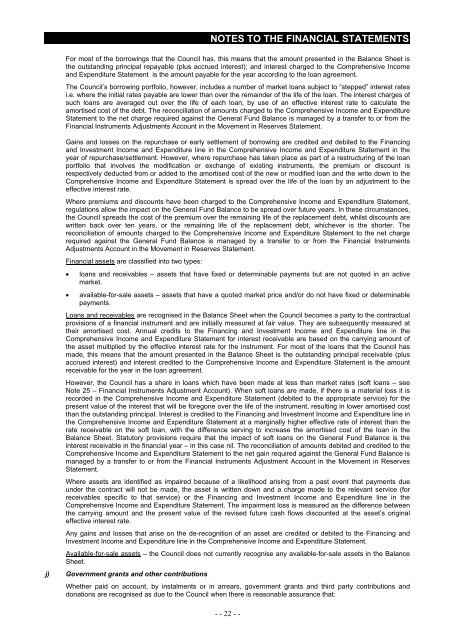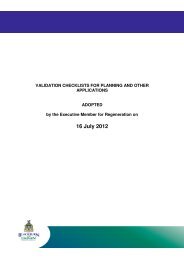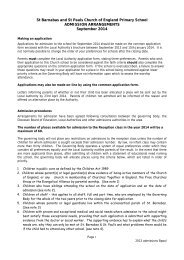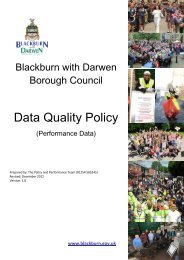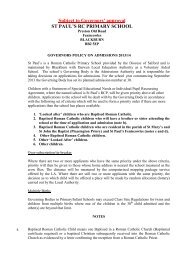Statement of Accounts 2011/2012 - Blackburn with Darwen Borough ...
Statement of Accounts 2011/2012 - Blackburn with Darwen Borough ...
Statement of Accounts 2011/2012 - Blackburn with Darwen Borough ...
You also want an ePaper? Increase the reach of your titles
YUMPU automatically turns print PDFs into web optimized ePapers that Google loves.
NOTES TO THE FINANCIAL STATEMENTS<br />
For most <strong>of</strong> the borrowings that the Council has, this means that the amount presented in the Balance Sheet is<br />
the outstanding principal repayable (plus accrued interest); and interest charged to the Comprehensive Income<br />
and Expenditure <strong>Statement</strong> is the amount payable for the year according to the loan agreement.<br />
The Council’s borrowing portfolio, however, includes a number <strong>of</strong> market loans subject to “stepped” interest rates<br />
i.e. where the initial rates payable are lower than over the remainder <strong>of</strong> the life <strong>of</strong> the loan. The interest charges <strong>of</strong><br />
such loans are averaged out over the life <strong>of</strong> each loan, by use <strong>of</strong> an effective interest rate to calculate the<br />
amortised cost <strong>of</strong> the debt. The reconciliation <strong>of</strong> amounts charged to the Comprehensive Income and Expenditure<br />
<strong>Statement</strong> to the net charge required against the General Fund Balance is managed by a transfer to or from the<br />
Financial Instruments Adjustments Account in the Movement in Reserves <strong>Statement</strong>.<br />
Gains and losses on the repurchase or early settlement <strong>of</strong> borrowing are credited and debited to the Financing<br />
and Investment Income and Expenditure line in the Comprehensive Income and Expenditure <strong>Statement</strong> in the<br />
year <strong>of</strong> repurchase/settlement. However, where repurchase has taken place as part <strong>of</strong> a restructuring <strong>of</strong> the loan<br />
portfolio that involves the modification or exchange <strong>of</strong> existing instruments, the premium or discount is<br />
respectively deducted from or added to the amortised cost <strong>of</strong> the new or modified loan and the write down to the<br />
Comprehensive Income and Expenditure <strong>Statement</strong> is spread over the life <strong>of</strong> the loan by an adjustment to the<br />
effective interest rate.<br />
Where premiums and discounts have been charged to the Comprehensive Income and Expenditure <strong>Statement</strong>,<br />
regulations allow the impact on the General Fund Balance to be spread over future years. In these circumstances,<br />
the Council spreads the cost <strong>of</strong> the premium over the remaining life <strong>of</strong> the replacement debt, whilst discounts are<br />
written back over ten years, or the remaining life <strong>of</strong> the replacement debt, whichever is the shorter. The<br />
reconciliation <strong>of</strong> amounts charged to the Comprehensive Income and Expenditure <strong>Statement</strong> to the net charge<br />
required against the General Fund Balance is managed by a transfer to or from the Financial Instruments<br />
Adjustments Account in the Movement in Reserves <strong>Statement</strong>.<br />
Financial assets are classified into two types:<br />
• loans and receivables – assets that have fixed or determinable payments but are not quoted in an active<br />
market.<br />
• available-for-sale assets – assets that have a quoted market price and/or do not have fixed or determinable<br />
payments.<br />
Loans and receivables are recognised in the Balance Sheet when the Council becomes a party to the contractual<br />
provisions <strong>of</strong> a financial instrument and are initially measured at fair value. They are subsequently measured at<br />
their amortised cost. Annual credits to the Financing and Investment Income and Expenditure line in the<br />
Comprehensive Income and Expenditure <strong>Statement</strong> for interest receivable are based on the carrying amount <strong>of</strong><br />
the asset multiplied by the effective interest rate for the instrument. For most <strong>of</strong> the loans that the Council has<br />
made, this means that the amount presented in the Balance Sheet is the outstanding principal receivable (plus<br />
accrued interest) and interest credited to the Comprehensive Income and Expenditure <strong>Statement</strong> is the amount<br />
receivable for the year in the loan agreement.<br />
However, the Council has a share in loans which have been made at less than market rates (s<strong>of</strong>t loans – see<br />
Note 25 – Financial Instruments Adjustment Account). When s<strong>of</strong>t loans are made, if there is a material loss it is<br />
recorded in the Comprehensive Income and Expenditure <strong>Statement</strong> (debited to the appropriate service) for the<br />
present value <strong>of</strong> the interest that will be foregone over the life <strong>of</strong> the instrument, resulting in lower amortised cost<br />
than the outstanding principal. Interest is credited to the Financing and Investment Income and Expenditure line in<br />
the Comprehensive Income and Expenditure <strong>Statement</strong> at a marginally higher effective rate <strong>of</strong> interest than the<br />
rate receivable on the s<strong>of</strong>t loan, <strong>with</strong> the difference serving to increase the amortised cost <strong>of</strong> the loan in the<br />
Balance Sheet. Statutory provisions require that the impact <strong>of</strong> s<strong>of</strong>t loans on the General Fund Balance is the<br />
interest receivable in the financial year – in this case nil. The reconciliation <strong>of</strong> amounts debited and credited to the<br />
Comprehensive Income and Expenditure <strong>Statement</strong> to the net gain required against the General Fund Balance is<br />
managed by a transfer to or from the Financial Instruments Adjustment Account in the Movement in Reserves<br />
<strong>Statement</strong>.<br />
Where assets are identified as impaired because <strong>of</strong> a likelihood arising from a past event that payments due<br />
under the contract will not be made, the asset is written down and a charge made to the relevant service (for<br />
receivables specific to that service) or the Financing and Investment Income and Expenditure line in the<br />
Comprehensive Income and Expenditure <strong>Statement</strong>. The impairment loss is measured as the difference between<br />
the carrying amount and the present value <strong>of</strong> the revised future cash flows discounted at the asset’s original<br />
effective interest rate.<br />
Any gains and losses that arise on the de-recognition <strong>of</strong> an asset are credited or debited to the Financing and<br />
Investment Income and Expenditure line in the Comprehensive Income and Expenditure <strong>Statement</strong>.<br />
Available-for-sale assets – the Council does not currently recognise any available-for-sale assets in the Balance<br />
Sheet.<br />
j) Government grants and other contributions<br />
Whether paid on account, by instalments or in arrears, government grants and third party contributions and<br />
donations are recognised as due to the Council when there is reasonable assurance that:<br />
- - 22 - -


